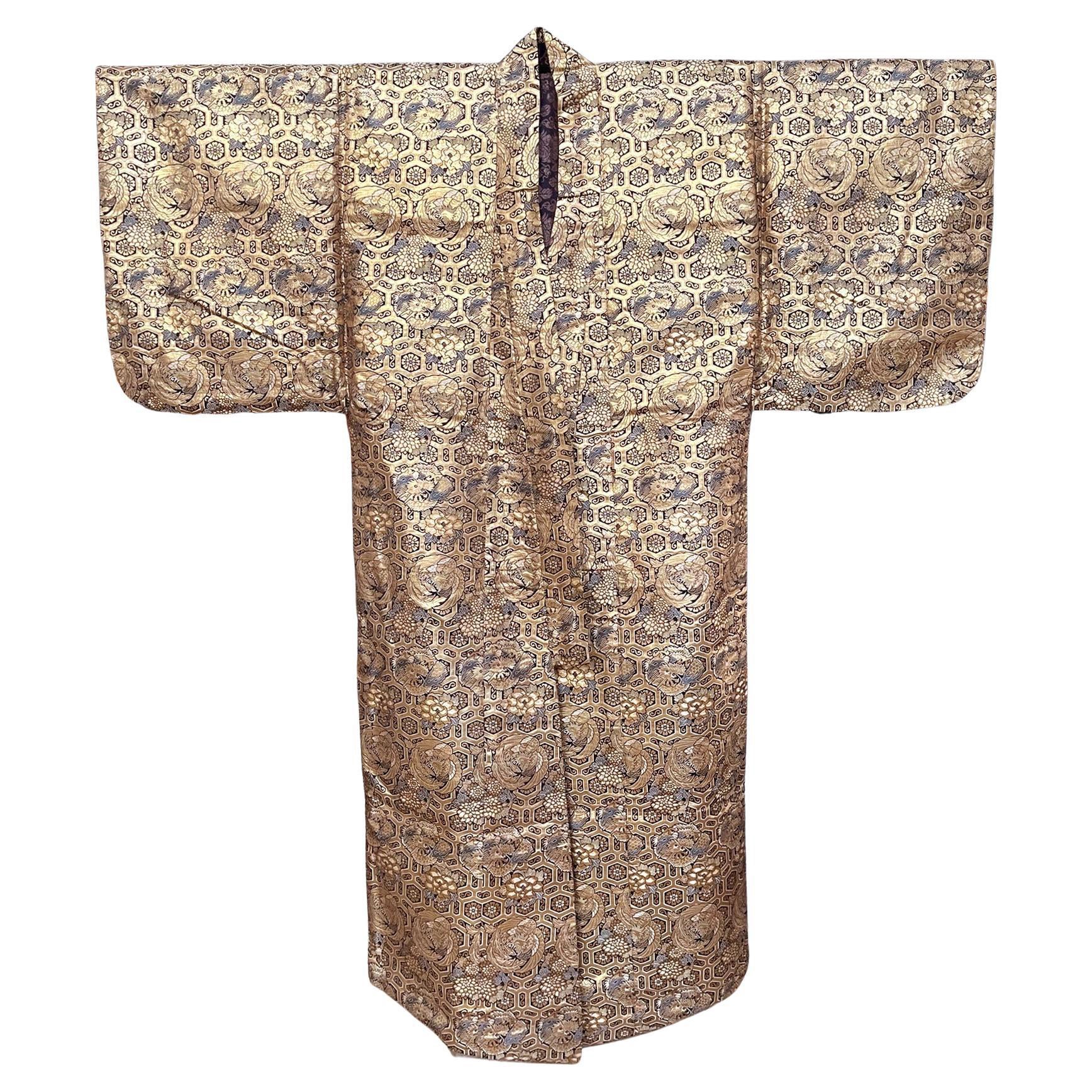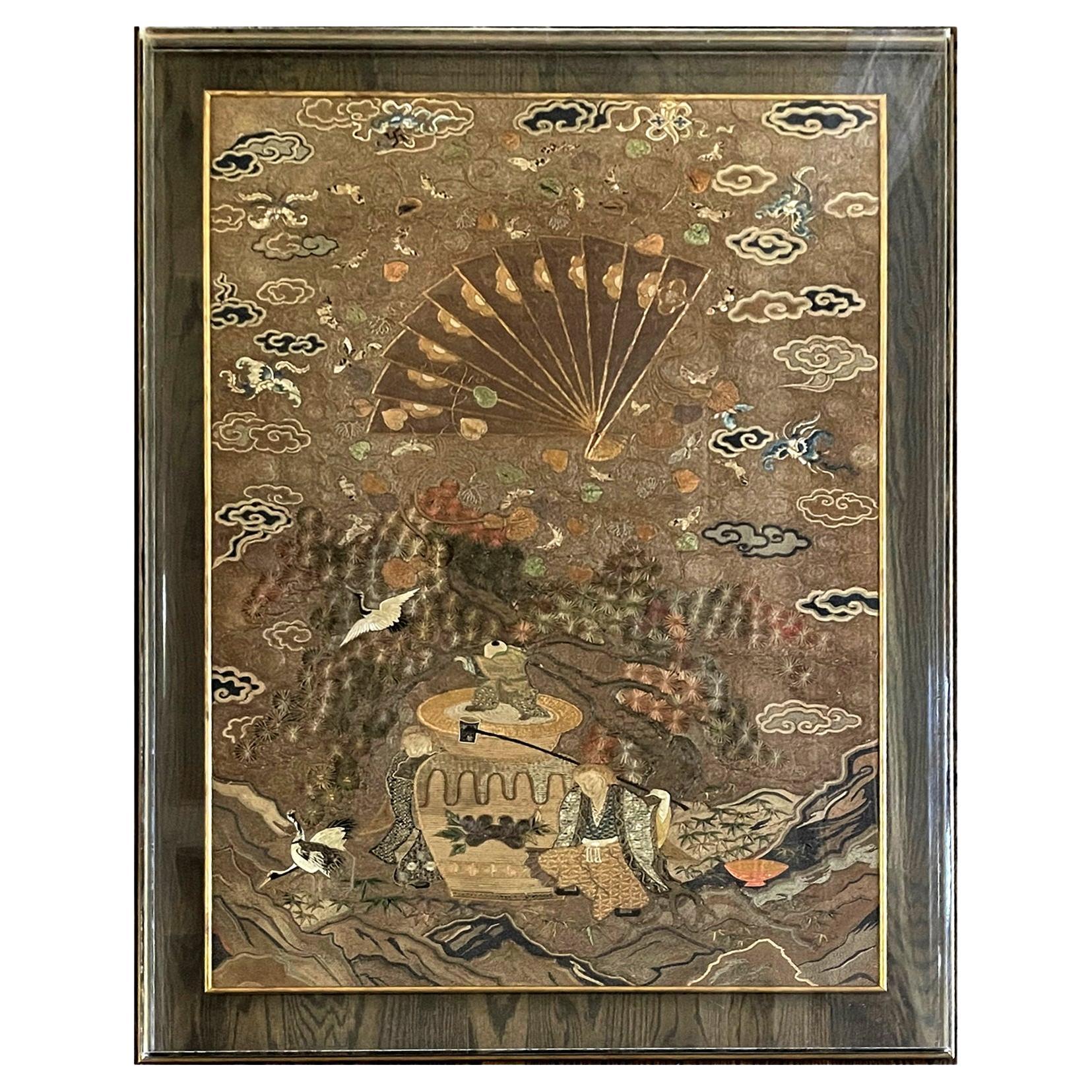Items Similar to Late Meiji Period Sleeping Kimono / Yogi, Japan
Want more images or videos?
Request additional images or videos from the seller
1 of 8
Late Meiji Period Sleeping Kimono / Yogi, Japan
About the Item
Late Meiji Period sleeping Kimono / Yogi, Japan
Yogi are a type of oversized sleeping kimono traditionally used in Japan. This kimono would have been stuffed with cotton wadding similar to a futon. The cotton and lining have been removed, leaving only the outer over-sized kimono. The collar was likely replaced a number of times during the life of this yogi.
- Dimensions:Height: 60 in (152.4 cm)Width: 56 in (142.24 cm)Depth: 2 in (5.08 cm)
- Style:Tribal (In the Style Of)
- Materials and Techniques:Cotton,Hand-Woven
- Place of Origin:
- Period:
- Date of Manufacture:1868-1911
- Condition:Wear consistent with age and use. Very good condition with minor repairs.
- Seller Location:Point Richmond, CA
- Reference Number:
About the Seller
4.9
Platinum Seller
These expertly vetted sellers are 1stDibs' most experienced sellers and are rated highest by our customers.
Established in 1999
1stDibs seller since 2015
607 sales on 1stDibs
Typical response time: 2 hours
- ShippingRetrieving quote...Ships From: Santa Fe, NM
- Return PolicyA return for this item may be initiated within 3 days of delivery.
More From This SellerView All
- Meiji Period Japanese Indigo Double Ikat Futon CoverLocated in Point Richmond, CAMeiji period Japanese Indigo double ikat futon cover Japanese futon cover, a double ikat pattern in four panels depicting Kumamoto Castle with im...Category
Antique 1890s Japanese Meiji Textiles
MaterialsCotton
- Taisho-Early Showa Period Japanese Stencil-Dyed Summer Kimono with Bamboo MotifLocated in Point Richmond, CATaisho-Early Showa period Japanese Stencil-Dyed Summer Kimono with bamboo Motif A light-weight summer kimono woven of both cotton and silk, and patter...Category
Mid-20th Century Japanese Taisho Textiles
MaterialsCotton, Silk
- Late 19th Century Wrapping Cloth / Furoshiki, JapanLocated in Point Richmond, CALate 19th century wrapping cloth / furoshiki, Japan Hand-drawn resist-dyed (tsutsugaki) in natural indigo, this large wrapping cloth (furoshiki) disp...Category
Antique Late 19th Century Japanese Meiji Textiles
MaterialsCotton
- Late 19th Century Japanese Stencil-Dyed Textile / Kumano-zomeLocated in Point Richmond, CALate 19th Century Japanese Stencil-Dyed Textile / Kumano-zome This 2-panel cotton textile was made in the Kumano region of Okayama Prefecture in th...Category
Antique Late 19th Century Japanese Meiji Textiles
MaterialsCotton
- Saki-Ori Farmers Coat, Northern Japan, Meiji PeriodLocated in Point Richmond, CASaki-ori farmers coat, Northern Japan, Meiji period A very heavy and substantial saki-ori coat, made of cotton with an indigo kasuri lapel. Several patches of hand sewn stitching ...Category
20th Century Japanese Meiji Textiles
MaterialsCotton
- Early 20th Century Japanese Linen Go-Board Pattern Futon CoverLocated in Point Richmond, CAEarly 20th Century Japanese linen go-board pattern futon cover A unique example of a game-themed textile, this 3-panel futon cover is woven of very fine...Category
Early 20th Century Japanese Meiji Textiles
MaterialsHemp
You May Also Like
- Japanese Brocade Noh Costume Kimono Robe Meiji PeriodLocated in Atlanta, GAA Noh costume made from magnificent silk twill brocade woven with metallic gold threads circa 1930s. The robe is identified as "Atsuita", made for male actors in the Noh play. The luxuriant fabric has a deep blue background with golden interlocking hexagon pattern that resembles tortoise shells, the symbol of longevity. The motifs showcase three auspicious symbols in repetitive patterns: roundels of coiled dragon, phoenix and peony. The kimono robe...Category
20th Century Japanese Meiji Textiles
MaterialsBrocade, Silk
- Japanese Silk Embroidery Tapestry Meiji PeriodLocated in Atlanta, GAA spectacular Japanese embroidered silk panel beautifully presented in a gilt frame suspended in a lucite shadow box with gilt wood border. The silk picture is dated to 1890-1910s toward the end of Meiji Period, when Japanese started to participate international expose by presenting its best art and craft. Elaborate embroidered silk tapestry like this was very popular among westerners due to its superb craftmanship and also exotic subject matter that was often derived from classic Japanese folklore, mythology and various motifs. The tapestry on offer is such an example. It depicts an old couple...Category
Antique 1890s Japanese Japonisme Textiles
MaterialsFabric, Silk, Lucite
- Large Japanese Embroidery Tapestry Meiji PeriodLocated in Atlanta, GAA large and finely embroidered Japanese tapestry with brocade border, circa 1900s Meiji period. The tapestry depicts, in a rather realistic style, a forested landscape in autumn flan...Category
Early 20th Century Japanese Japonisme Textiles
MaterialsBrocade, Silk
- Framed Japanese Fukusa Textile Art Meiji PeriodLocated in Atlanta, GAA Japanese Fukusa textile panel circa late 19th-early 20th century of Meiji Period. On the woven brocade background with gold thread forming clouds and...Category
Antique Late 19th Century Japanese Japonisme Textiles
MaterialsSilk, Giltwood
- Massive Japanese Embroidery Tapestry Display Box Meiji PeriodLocated in Atlanta, GAA massive Japanese embordered tapestry professionally displayed in a custom acrylic shadow box. The fine work of textile art is dated to 1890-1920s, late Meiji (1868-1912) or possibl...Category
Early 20th Century Japanese Japonisme Textiles
MaterialsBrocade, Silk, Acrylic
- Antique Japanese Brocade Kesa Monk's Robe Meiji PeriodLocated in Atlanta, GAA stunning Japanese Kesa (Monk's Vestment) made from thirteen columns of patchworks of shimmering woven brocades. The elaborate motifs feature repetitive...Category
Antique Late 19th Century Japanese Meiji Textiles
MaterialsBrocade, Silk
Recently Viewed
View AllMore Ways To Browse
Late Antique Period
Japanese Cotton
Japan Textiles
Japanese Textile
Japanese Late Meiji
Kimono Japan
Black Kimono
Japanese Kimono Art
Woven Collar
Traditional Japanese Textiles
Kimono Antique
Antique Kimono
Antique Kimonos
Antique Japanese Textiles Textiles
Antique Japanese Textile
Antique Japanese Textiles
Japanese Antique Textiles
Asian Kimonos





